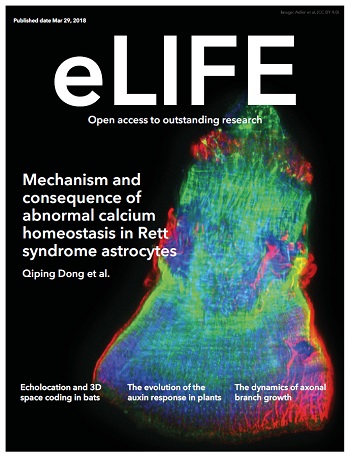早期斯约金氏病小鼠模型中失调的 Ca2+ 信号、液体分泌和线粒体功能
IF 6.4
1区 生物学
Q1 BIOLOGY
引用次数: 0
摘要
导致唾液分泌的分子机制已基本确定,但导致分泌功能低下的因素,特别是与自身免疫性疾病斯约格伦综合征(SS)有关的因素尚未完全明了。一个主要的难题是唾液腺免疫细胞浸润的严重程度与腺体功能减退之间缺乏关联。用小鼠 STING 的小分子激动剂 DMXAA 治疗可诱发 SS 样疾病。我们之前已经证明,唾液分泌的程度与细胞内 Ca2+ 信号的大小相关(Takano 等人,2021 年)。与我们的预期相反,尽管唾液分泌显著减少,神经刺激却导致 Ca2+ 信号增强,并改变了体内的时空特征。Muscarinic 刺激导致 Ca2+ 激活的 Cl- 通道 TMEM16a 的激活减少,尽管通道丰度或对 Ca2+ 的绝对敏感性没有变化。超分辨显微镜显示,1,4,5-三磷酸肌醇受体 Ca2+ 释放通道与 TMEM16a 的共定位发生了破坏,当细胞内 Ca2+ 缓冲作用增加时,通道的激活也会降低。这些数据表明通道之间的局部外周耦合发生了改变。适当的 Ca2+ 信号传导对线粒体形态和生物能也至关重要。经 DMXAA 处理的动物线粒体形态紊乱,耗氧率降低。总之,在 SS 疾病的早期,失调的 Ca2+ 信号会导致液体分泌减少和线粒体功能紊乱,从而导致唾液腺功能低下。本文章由计算机程序翻译,如有差异,请以英文原文为准。
Dysregulated Ca2+ signaling, fluid secretion, and mitochondrial function in a mouse model of early Sjögren’s disease
The molecular mechanisms leading to saliva secretion are largely established, but factors that underlie secretory hypofunction, specifically related to the autoimmune disease Sjögren’s syndrome (SS) are not fully understood. A major conundrum is the lack of association between the severity of salivary gland immune cell infiltration and glandular hypofunction. SS-like disease was induced by treatment with DMXAA, a small molecule agonist of murine STING. We have previously shown that the extent of salivary secretion is correlated with the magnitude of intracellular Ca2+ signals (Takano et al., 2021). Contrary to our expectations, despite a significant reduction in fluid secretion, neural stimulation resulted in enhanced Ca2+ signals with altered spatiotemporal characteristics in vivo. Muscarinic stimulation resulted in reduced activation of the Ca2+-activated Cl- channel, TMEM16a, although there were no changes in channel abundance or absolute sensitivity to Ca2+. Super-resolution microscopy revealed a disruption in the colocalization of Inositol 1,4,5-trisphosphate receptor Ca2+ release channels with TMEM16a, and channel activation was reduced when intracellular Ca2+ buffering was increased. These data indicate altered local peripheral coupling between the channels. Appropriate Ca2+ signaling is also pivotal for mitochondrial morphology and bioenergetics. Disrupted mitochondrial morphology and reduced oxygen consumption rate were observed in DMXAA-treated animals. In summary, early in SS disease, dysregulated Ca2+ signals lead to decreased fluid secretion and disrupted mitochondrial function contributing to salivary gland hypofunction.
求助全文
通过发布文献求助,成功后即可免费获取论文全文。
去求助
来源期刊

eLife
BIOLOGY-
CiteScore
12.90
自引率
3.90%
发文量
3122
审稿时长
17 weeks
期刊介绍:
eLife is a distinguished, not-for-profit, peer-reviewed open access scientific journal that specializes in the fields of biomedical and life sciences. eLife is known for its selective publication process, which includes a variety of article types such as:
Research Articles: Detailed reports of original research findings.
Short Reports: Concise presentations of significant findings that do not warrant a full-length research article.
Tools and Resources: Descriptions of new tools, technologies, or resources that facilitate scientific research.
Research Advances: Brief reports on significant scientific advancements that have immediate implications for the field.
Scientific Correspondence: Short communications that comment on or provide additional information related to published articles.
Review Articles: Comprehensive overviews of a specific topic or field within the life sciences.
 求助内容:
求助内容: 应助结果提醒方式:
应助结果提醒方式:


